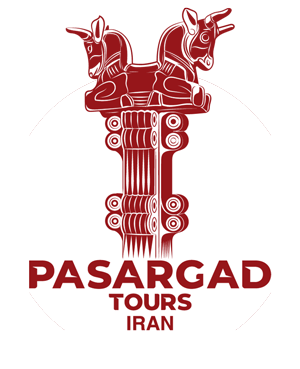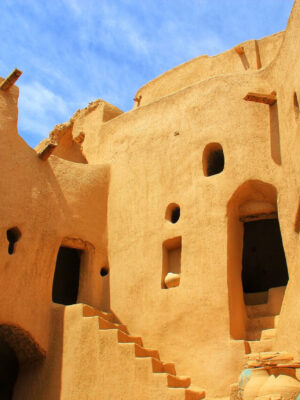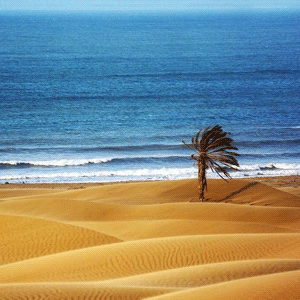Bam and Its Cultural Landscape
Bam and its Cultural Landscape property is located in Kerman province on the southern edge of the Iranian high plateau at an altitude of 1100 meters. Arg-e Bam (Bam Citadel) is the largest adobe building in the world and exemplar of a fortified medieval town constructed utilizing locally available resources and traditions, which included using mud layers (chineh), sun-dried mud bricks (khesht), along with vaulted and domed structures.
Bam is a large oasis situated in the center of a valley between the Kafut Mountains in the north and the Jebal-e Barez Mountains in the south. Behind the mountains is the expansive Lut Desert of Central Iran. Water from the Jebal-e Barez Mountains supplies the seasonal Posht-e Rud River that goes around Bam City between Arg-e Bam and Qal’eh Doktar. However, since the dry season lasts most of the year, crucial to the town’s survival is its system of twenty-five qanats (underground irrigation channels) of which Bam has preserved some of the earliest evidence in Iran. Bam has sustained evidence of the technological development in the building and maintenance of qanats for over two-thousand years.

The origins of Bam Citadel can be traced back to the Achaemenid period (6th to 4th centuries BC) and even beyond. The citadel flourished from the 7th to 11th centuries, for it was located at the juncture of Silk Roads and famed for the production of silk and fine cotton garments. These routes which connected Bam to Central Asia in the east, the Persian Gulf in the south, and Egypt in the west provided for a mutual interchange of cultures.
The area of Bam Citadel is about 180,000 square meters, surrounded by walls 6 to 7 meters high. The remarkable citadel, which includes the governor’s quarters and the fortified residential area, is the central focus of an extensive cultural landscape marked by the remains of a series of forts and citadels. Outside the core area of Arg-e Bam, there are other protected historic structures which include Qal’eh Dokhtar (Maiden’s fortress, 7th century), two mausoleums (11th- 12th century), the historic qanat systems and cultivations southeast of the Arg. The citadel was badly damaged in an earthquake in 2003; it has since been largely restored while maintaining the character of the property.
Bam and its Cultural Landscape is an excellent example of an ancient fortified settlement that developed around the desert environment of the Iranian central plateau. It is an embodiment of the relationship between man and nature as evidenced by the settlements and the qanats (which have been preserved and are still in use). Bam also aptly represents the development of a trading settlement and an interchange of influences in the desert environment of the Central Asian region.
Bam and Its Cultural Landscape
Bam and its Cultural Landscape property is located in Kerman province on the southern edge of the Iranian high plateau at an altitude of 1100 meters. Arg-e Bam (Bam Citadel) is the largest adobe building in the world and exemplar of a fortified medieval town constructed utilizing locally available resources and traditions, which included using mud layers (chineh), sun-dried mud bricks (khesht), along with vaulted and domed structures.
Bam is a large oasis situated in the center of a valley between the Kafut Mountains in the north and the Jebal-e Barez Mountains in the south. Behind the mountains is the expansive Lut Desert of Central Iran. Water from the Jebal-e Barez Mountains supplies the seasonal Posht-e Rud River that goes around Bam City between Arg-e Bam and Qal’eh Doktar. However, since the dry season lasts most of the year, crucial to the town’s survival is its system of twenty-five qanats (underground irrigation channels) of which Bam has preserved some of the earliest evidence in Iran. Bam has sustained evidence of the technological development in the building and maintenance of qanats for over two-thousand years.

The origins of Bam Citadel can be traced back to the Achaemenid period (6th to 4th centuries BC) and even beyond. The citadel flourished from the 7th to 11th centuries, for it was located at the juncture of Silk Roads and famed for the production of silk and fine cotton garments. These routes which connected Bam to Central Asia in the east, the Persian Gulf in the south, and Egypt in the west provided for a mutual interchange of cultures.
The area of Bam Citadel is about 180,000 square meters, surrounded by walls 6 to 7 meters high. The remarkable citadel, which includes the governor’s quarters and the fortified residential area, is the central focus of an extensive cultural landscape marked by the remains of a series of forts and citadels. Outside the core area of Arg-e Bam, there are other protected historic structures which include Qal’eh Dokhtar (Maiden’s fortress, 7th century), two mausoleums (11th- 12th century), the historic qanat systems and cultivations southeast of the Arg. The citadel was badly damaged in an earthquake in 2003; it has since been largely restored while maintaining the character of the property.
Bam and its Cultural Landscape is an excellent example of an ancient fortified settlement that developed around the desert environment of the Iranian central plateau. It is an embodiment of the relationship between man and nature as evidenced by the settlements and the qanats (which have been preserved and are still in use). Bam also aptly represents the development of a trading settlement and an interchange of influences in the desert environment of the Central Asian region.





















